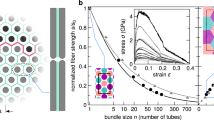Abstract
A connection between the stiffness of carbon nanotubes (CNT) and their mesoscopic physical behaviour is presented. Persistence lengths of CNT and bundles are calculated and shown to be in macroscopic range (0.03–1 mm for an individual tube), exceeding by many orders of magnitude the typical diameters (around 1–3 nm). Consequently, thermal fluctuations can be neglected when scaling analysis is applied to randomly packed (as produced) CNT network, leading to an approximate equation of state for such material. Beyond the linear elasticity, the outmost CNT are shown to gradually split from the bent bundles; this permits access of solvent or reacting species to the CNT walls, an important mechanism promoting solubilization and chemical functionalization of nanotubes.
Similar content being viewed by others
References
Astrom J.A., Krasheninnikov A.V. and Nordlund K. (2004). Carbon nanotube mats and fibers with irradiation-improved mechanical characteristics: A theoretical model. Phys. Rev. Lett. 93: 215503
de-Gennes P.G. (1979). Scaling Concepts in Polymer Physics. Cornell Univ Press, Ithaca
Doi M. and Edwards S.F. (1986). The Theory of Polymer Dynamics. Clarendon Press, Oxford
Dyke C.A. and Tour J.M. (2003). Solvent-free functionalization of carbon nanotubes. JACS 125: 1156–1157
Girifalco L.A., Hodak M. and Lee R.S. (2000). Carbon nanotubes, buckyballs, ropes, and a universal graphitic potential. Phys. Rev. B 62: 13104–13110
Harris P.J.F. (1999). Carbon Nanotubes and Related Structures. Cambridge University, Cambridge
Hernandez E., Goze C., Bernier P. and Rubio A. (1998). Elastic properties of C and BxCyNz composite nanotubes. Phys. Rev. Lett. 80: 4502–4505
Kim W., Choi H.C., Shim M., Li Y.M., Wang D.W. and Dai H.J. (2002). Synthesis of ultralong and high percentage of semiconducting single-walled carbon nanotubes. Nano Lett. 2: 703–708
Kis A. and Csanyi G. (2004). Reinforcement of single-walled carbon nanotube bundles by intertube bridging. Nature Mater. 3: 153–157
Kudin K.N., Scuseria G.E. and Yakobson B.I. (2001). C2F, BN and C nano-shell elasticity by ab initio computations. Phys. Rev. B 64: 235–406
Landau L.D. and Lifshitz E.M. (1986). Elasticity Theory. Pergamon, Oxford
Li Z., Dharap P., Nagarajaiah S., Nordgren R.P. and Yakobson B.I. (2004). Nonlinear analysis of SWCNT over a bundle of nanotubes. Intern. J. solids and structures 41: 6925–6936
Liu J. and Rinzler A.G. (1998). Fullerene pipes. Science 280: 1253–1256
Liu J.Z., Zheng Q.S., Wang L.F. and Jiang Q. (2005). Mechanical properties of single-walled carbon nanotube bundles as bulk materials. J. Mech. Phys. Sol. 53: 123–142
Lu J.P. (1997). Elastic properties of carbon nanotubes and nanoropes. Phys. Rev. Lett. 79: 1297–1300
Martel R., Shea H.R. and Avouris P. (1999). Ring Formation in Single-Wall Carbon Nanotubes. J. Phys. Chem. 103: 7551
O’Connell M.J. and Bachilo S.M. (2002). Band gap fluorescence from individual single-walled carbon nanotubes. Science 297: 593–596
O’Connell M.J. and Boul P. (2001). Reversible water-solubilization of single-walled carbon nanotubes by polymer wrapping. Chem. Phys. Lett. 342: 265–271
Pikhitsa P.V. (2004). Regular network of contacting cylinders with Implications for materials with negative Poisson ratios. Phys. Rev. Lett. 93: 015505
Salvetat J.-P. and Briggs G.A. (1999a). Elastic and shear moduli of single-walled carbon nanotube ropes. Phys. Rev. Lett. 82: 944–947
Salvetat J.-P. and Kulik A.J. (1999b). Elastic modulus of ordered and disordered multiwalled carbon nanotubes. Adv. Mater. 11: 161–165
Sanchez-Portal D., Artacho E., Soler J.M., Rubio A. and Ordejon P. (1999). Ab initio structural, elastic, and vibrational properties of carbon nanotubes. Phys. Rev. B 59: 12678–12688
Sano M., Kamino A., Okamura J. and Shinkai S. (2001). Ring closure of carbon nanotubes. Science 293: 1299–1301
Suslick K.S. and Price G. (1999). Applications of ultrasound to materials chemistry. Annu. Rev. Mater. Sci. 29: 295–326
Tersoff J. and Ruoff R.S. (1994). Structural properties of a carbon-nanotube crystal. Phys. Rev. Lett. 73: 676–679
Yakobson B.I. (1998). Mechanical relaxation and ‘Intramolecular Plasticity’ in carbon nanotubes. Appl. Phys. Lett. 72: 918–920
Yakobson, B.I., 2003. In: Goddard W.A. ed. Nanomechanics. Handbook of Nanoscience, Engineering, and Technology., CRC, New York, pp. 17.1–18
Yakobson, B.I. & P. Avouris. 2001. Mechanical Properties of Carbon Nanotubes. Topics Appl. Phys. pp. 287–327
Yakobson B.I., Brabec C.J. and Bernholc J. (1996). Nanomechanics of carbon tubes: Instabilities beyond the linear response. Phys. Rev. Lett. 76: 2511–2514
Yang W., Li Z.-M., Shi W., Xie B.-H. and Yang M.-B. (2004). Review on auxetic materials. J. Mater. Sci. 39: 3269–3279
Author information
Authors and Affiliations
Corresponding author
Rights and permissions
About this article
Cite this article
Yakobson, B.I., Couchman, L.S. Persistence Length and Nanomechanics of Random Bundles of Nanotubes. J Nanopart Res 8, 105–110 (2006). https://doi.org/10.1007/s11051-005-8335-3
Received:
Accepted:
Published:
Issue Date:
DOI: https://doi.org/10.1007/s11051-005-8335-3




